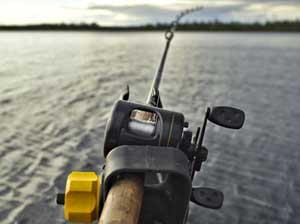Fishing Techniques – Trolling

Trolling is the process of placing fishing lines behind a moving boat. The lines can be baited with lures or live bait.
Getting started
Many bass anglers prefer casting to trolling. However trolling with crankbaits is far more accurate at various depths than casting.
*The secret is controlling the depth and the speed of the lures or bait.
To judge depth:
- let out 100 feet of 10lb test line
- watch the depth finder and write down the depth where the lure finally clips bottom
- try this out several times with different lures and baits in order to pick the best one for any given depth
Surface Trolling
- We recommend surface trolling when lake temperatures are uniform. Usually this is in the spring and fall. When the water is cool, bass come to the surface and feed here.
The best places to troll include feeder streams, over rocky shallows and around any underwater structure such as debris.
Technique for trolling
Move the rod in long motions in order to keep the streamer moving in and out of the wake. To fly troll, slow the boat and add a split shot or two to the leader.
Trolling lures including minnow-like plugs, wobbling spoons and jigs can be used with light spinning equipment. However make sure you use the same sweeping motion.
Set the drag on the light side and avoid line twists by adding a ball-bearing snap swivel to the line.
Trolling for largemouth bass works well with a large top-water plug at least 50 feet behind the boat.
- This is effective on windy and overcast days when the bass return from deepwater to feed at the surface.
- On warm and sunny days, best success can be achieved at dawn and dusk.
If you’re close to the outskirts of weed beds, trolling with a jitterbug slowly works well when the line is about 50 feet behind the boat.
 Deep Water Trolling
Deep Water Trolling
If you’re trolling for deep water bass, let out 100 yards of line between the rod and the lure. At this distance, tension between the rod and the lure is weak. Therefore, don’t use a holder when sensitivity is low or you’ll have trouble detecting light strikes. Instead hold the line for better results.
When fishing the deep, a downrigger is recommended as it allows the lure or bait to be set at precise depths. Use a metal weight attached on a cable. The fishing line is attached to a release that trips when a fish is on hook.
For those anglers who prefer to play and enjoy a cold beverage between strikes, the downrigger is the perfect tool. (Some anglers claim this takes away from the experience.)
Trolling Planer
This is a relatively new invention. These have a single purpose which is to allow anglers to manage more than one line in the water at a time and at different depths
Double Planer Boards
Most anglers choose the double planer board configuration with one on either side of the boat.
Foam Planer Boards
Foam planer boards have the advantage of being cheaper than wooden boards costing as little as $20 and going as high as US$60.00.
Triple Planer Boards
Use of three planer boards is possible and a recommended configuration when trying to catch a lot of fish. This set up allows for a wider trolling wake.



